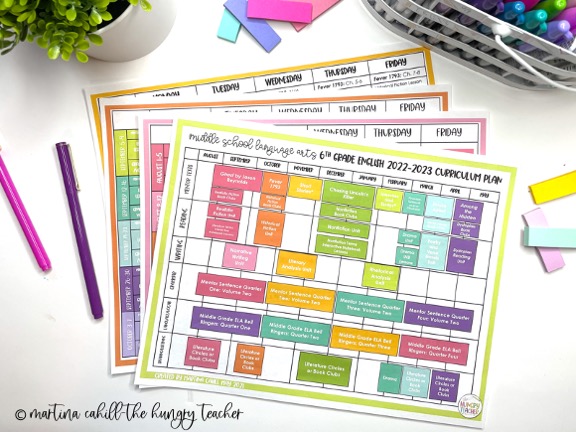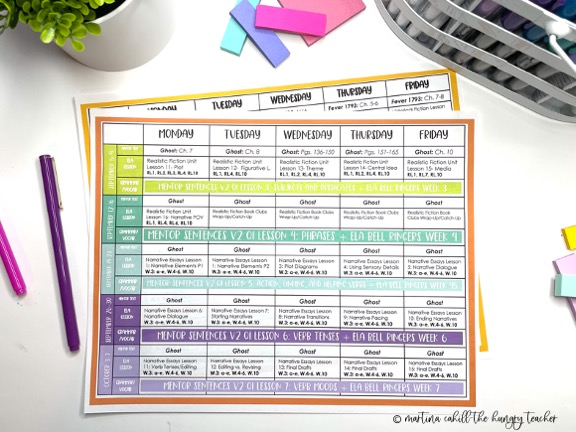hey friend!
I'm Martina.
I provide practical, time-saving strategies that actually work—so you can engage your students, teach effectively, and reclaim your time from the exhausting planning-grading cycle.
Browse Our ELA Resources
How I Map Out My School Year in Middle School ELA
In the past when I sat down to map out my middle school ELA curriculum, I had a strong desire to find any other way to spend my time. The entire list of standards, skills, and concepts that needed to be taught in a single school year completely overwhelmed me.
It can feel seemingly impossible to fit in every ELA standard to a school year, especially if you get those students for forty-five minutes a day.
A few years ago, I decided I was going to finally commit to making a well-thought-out middle school curriculum map that I could use again and again (with some tweaks here and there). It’s been a game-changer.
I have my middle school ELA curriculum maps available for free, and I am happy to share them with you. Even if you just need some ideas for creating your own maps, it’s sometimes helpful to see what other middle school ELA teachers are doing. You can download the curriculum maps for sixth grade, seventh grade, and eighth grade.
I also have an editable version of all the curriculum maps in my TpT store.

Middle School ELA Curriculum Map Breakdown

Look at the Big Picture: Planning the Year at a Glance
I want to dive deeper into exactly how I created these pacing guides, and how I planned out my entire year. I promise, there is a method to my madness!
???? First, I always start with the pacing guide or broad overview of the entire year. This helps me just generally break down the big topics I need to cover throughout the year.
I started with my big umbrella skills. These are the general skills our students need in ELA: mentor texts, reading, writing, grammar, language and vocab, and speaking listening. By looking at your standards, you can find these big umbrella skills they will expect students to know.
???? Next, take a look at your standards and note the specific genres students need to know. What specific writing and reading genres do students need to be exposed to? What are the big grammar rules to focus on? Continue to collect these big picture pieces of information.
For example, students may need to be familiar with folklore and myths, or write narrative and expository essays.
???? To create your pacing guide, spread out these larger topics, skills, and genres across the school year. For example, you may review narrative writing during the first semester, and expository during the second semester.

Getting Specific: Planning the Weekly and Daily Skills

???? Next, it’s time to get specific on the skills students are expected to know. I think this is where things get tricky on the curriculum map because people get nervous. What if I plan this all out, and then have to change it?
You will inevitably have to change and move items on your curriculum map, but the idea is that even with change – you stay on track because you planned with the end in mind. You can just shift the instructional days as needed.
In order to move to weekly and daily planning, look at the standards for your state and write down which skills need to be taught within a genre. For example, I need to teach setting, plot, point of view, inference, etc with fiction.
You will then “sprinkle” or spread these skills out over the period you planned to teach this on your year pacing guide. So, if you said August and September will focus on fiction, you will spread out the fiction skills across those two months.
???? Lastly, work smarter – not harder! If you have reading units, curriculum, or resources you have taught in the past, match this up with your plan.
For example, I have a nonfiction unit that I always use in my classroom. On the curriculum map, I went ahead and wrote in this unit where I planned to teach nonfiction.
Another example would be a mentor sentence bundle that you love for teaching grammar. Write this into your curriculum guide for your different grammar lessons.
???? Planning down to the day is really helpful for me because it keeps me accountable for teaching and hitting all the skills my students need to know. It’s easy to leave some behind without this planning.

Tips for Mapping Your Curriculum

Tip #1: Embed catch-up days into your unit planning, especially at the end of a unit. This gives you some buffer time to play with, or even gives you time to assess students about the unit.
Tip #2: Look at other people’s units. Especially if you are planning alone, it can feel really overwhelming to try to map your ELA curriculum solo. You can download my free middle school ELA curriculum maps for sixth grade, seventh grade, and eighth grade. I also have an editable version of the curriculum map.
Tip #3: If you are feeling overwhelmed, take it one step at a time. Before I mapped out my entire year, I used to take it six weeks or one quarter at a time. This helped make the planning feel more manageable.
Tip #4: If you are limited on class time, make use of your bell ringers and exit tickets. Without block classes, getting a book club or literature circle each week may feel difficult. Utilize your other time in class to incorporate the skills they may miss through those experiences.
If you want to get a deeper look into my daily class periods, schedules, and more you can check out my other blog post that breaks down what a day looks like in my middle school ELA classroom right HERE.
Want a sneak peek at teaching The Hungry Teacher way—with support, structure, and strategy?
When you join the waitlist for The Hungry Teacher’s Hub membership, you get three free classroom-ready resources: a theme unit, an expository writing unit, and a grammar unit introducing mentor sentences. Plus, you’ll get immediate access to a selection of exclusives from the Hub, including editable sub plans, pacing guides, and more.
No strings attached. Just resources you can use right now—and a heads-up when the Hub opens.
3 Free Middle School ELA Units—yours to keep!
JOIN THE WAITLIST + A FREE GIFT
Where to next, line leader?
Welcome to The Hungry Teacher! We create resources that are easy to use, practical, and get results. Teach with confidence—and make it home before dinner.
xo, the hungry teacher